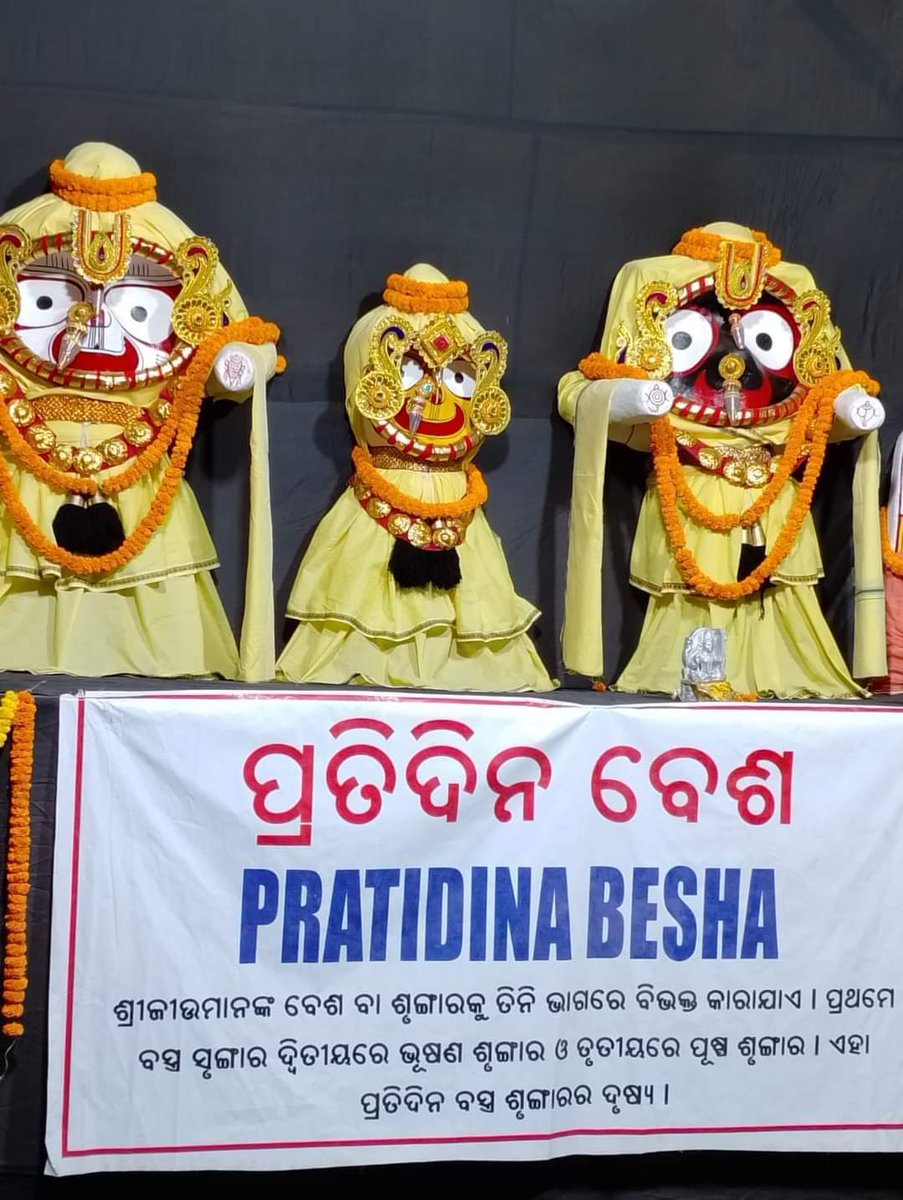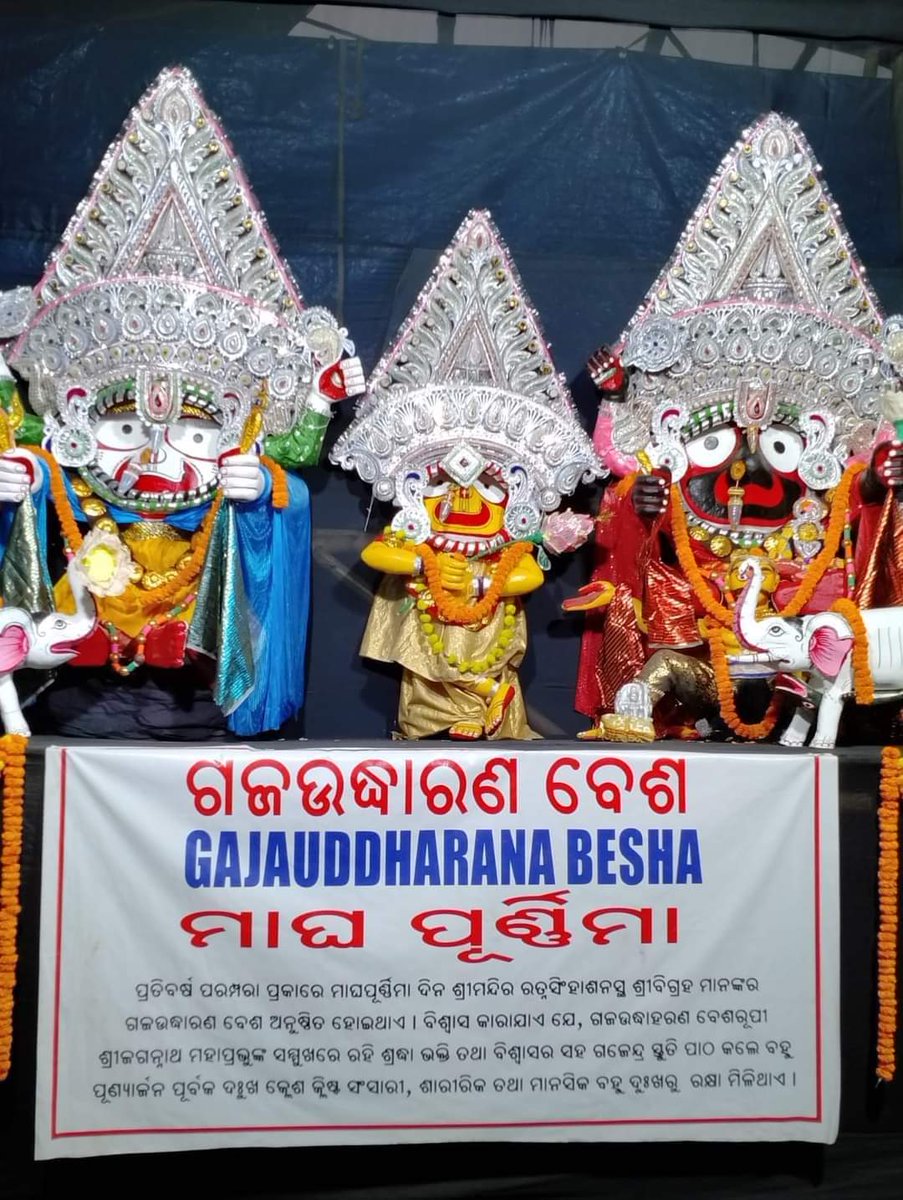🌺Did you know about the Divine costumes of Mahaprabhu Jagannath?🌺
Besha is a Sanskrit word, which means dress, costume or attire. The deities showing their close affinity with the human world does change their dresses/divine costumes with change in time.

Besha is a Sanskrit word, which means dress, costume or attire. The deities showing their close affinity with the human world does change their dresses/divine costumes with change in time.


The dresses, make up or the costume locally called as veshas starts changing with the first daily ritual of Mangala Aarati.
The rituals of the Shri Jagannath is based on anthropomorphic equation, where worshipped Gods are treated like human.
The rituals of the Shri Jagannath is based on anthropomorphic equation, where worshipped Gods are treated like human.

Whether it is waking up in the morning, taking an afternoon nap; or resting at night after dinner; the rites are modeled in a humanitarian way. It is stated that, the images change their clothes and wear different kinds of ornaments as many as eight times during a normal day. 

There are specific categories of servitors in the temple, who are experts in cladding the deities in particular types of Besha.
Three types of servitors, namely Puspalaka (Singhari), Khuntia and Changeda Mekap are entrusted with the responsibility of daily decoration or..
Three types of servitors, namely Puspalaka (Singhari), Khuntia and Changeda Mekap are entrusted with the responsibility of daily decoration or..

..Beshas of the deities. Palia Puspalaks are to decorate the deities on every occasion.
⚜️The deities are mainly embellished in three ways;
💮Bastra Singhar
💮Puspa Singhar
💮Alankar Singhar
⚜️The deities are mainly embellished in three ways;
💮Bastra Singhar
💮Puspa Singhar
💮Alankar Singhar

Except on the festive occasions they are attired in the ‘Bastra Singhar’ and ‘Puspa Singhar’ patterns. Everyday from the ‘Mangala Arati’ till ‘Ratri Pahuda’, the deities on the ‘Ratnavedi’ of Shree Jagannath Temple, Puri are adorned with cotton and silken fabrics, gold.. 

..ornaments studded with precious stones, flowers of several kinds and other leaves and herbs like Tulasi, Dayana, Marua etc. Sandal paste, camphor and at times precious musk are being used in the daily and periodical rituals. 

Garlands and other floral ornaments namely Adharmala, Chandrika, Gava, Alaka, Karapallava, Hruda Padaka, Kaustubha Padaka, Guna, Makara Kundala, Jhumpa, Tilaka, Kundala, Tadagi, Nakuasi, Sripayara Mala etc. are made out of prescribed types of.. 

..flowers, leaves of Tulasi(holy basil), Panasa (jackfruit) etc.
Specific dress (Monday to Sunday) of Shri Jagannath; Besides changing the dresses daily there are certain veshas which the deities use on some special occasions falling in different part of the year.
Specific dress (Monday to Sunday) of Shri Jagannath; Besides changing the dresses daily there are certain veshas which the deities use on some special occasions falling in different part of the year.

🌸There are 51 types of dresses (Bastra) of Shree Jagannath is used on several occasions as per the tradition of Srimandir Puri.🌸
The type of clothes is decided as per the day ( As per Panji -Bara) and the ruling planet of the day.
The type of clothes is decided as per the day ( As per Panji -Bara) and the ruling planet of the day.

🌺Sunday is ruled by Planet Sun (Ravi) so the deities wear the red color Patta. The color of Ruby.
🌺Monday is ruled by Planet Moon (Chandra) so the deities wear the White/Black color Patta. The color of Pearl.
🌺Monday is ruled by Planet Moon (Chandra) so the deities wear the White/Black color Patta. The color of Pearl.

🌺Tuesday is ruled by planet Mangal (Mars) so the deities wear the Barapatia Patta. The color of Coral/red/pink.
🌺Wednesday is ruled by Planet Mercury (Budha) so deities wear green color Patta. The color of emerald.
🌺Wednesday is ruled by Planet Mercury (Budha) so deities wear green color Patta. The color of emerald.

🌺Thursday is ruled by planet Jupiter (Brihaspati) So deities wear Yellow color Patta. The color of Yellow Sapphire.
🌺Friday is ruled by Planet Venus (Sukra) So deities wear white color Patta.The color of the diamond.
🌺Friday is ruled by Planet Venus (Sukra) So deities wear white color Patta.The color of the diamond.

🌺Saturday is ruled by Planet Saturn (Sani) So deities wear black color Patta.The color of the Blue Sapphire.
Shri Jagannatha has generally been identified with Sri Vishnu.But on certain particular festive occasions,the deities are decorated with different masquerades such as..
Shri Jagannatha has generally been identified with Sri Vishnu.But on certain particular festive occasions,the deities are decorated with different masquerades such as..

..Gajanana Besha, Nagarjun Besha, Padma Besha, Trivikram Besha, Kaliyadalan Besha, Gajauddharana Besha, Radha Damodar Besha etc.
It is so because Jagannatha culture encompasses within itself various cults such as Vaishnavism, Shakta-cult, Saivism, Ganapatya cult and..
It is so because Jagannatha culture encompasses within itself various cults such as Vaishnavism, Shakta-cult, Saivism, Ganapatya cult and..

..the tribal forms of worship. As such, the Beshas of Prabhu Shri Jagannatha symbolise a sort of religious and cultural synthesis, hence the three deities are decorated in such a way as to satisfy the spiritual aspiration of different sects, groups and sub-groups. 

These Beshas are mainly related to Lilas of Krishna, Rama, Baman, Ganesh etc.
Shri Jagannath's adherents participate in a variety of traditional festivities. During the celebration of different festivals, the deities change their dresses and put on different categories of..
Shri Jagannath's adherents participate in a variety of traditional festivities. During the celebration of different festivals, the deities change their dresses and put on different categories of..

..ceremonial costumes or dresses according to the nature of the festival.
💮Thirteen of the several festivals are significant.💮
1. Niladri Mahodaya
2. Snana Yatra
3. Shri Gundicha or Ratha Yatra
4. Shri Hari Sayan Yatra
5. Utthapan Yatra
6. Parswa Paribartan
💮Thirteen of the several festivals are significant.💮
1. Niladri Mahodaya
2. Snana Yatra
3. Shri Gundicha or Ratha Yatra
4. Shri Hari Sayan Yatra
5. Utthapan Yatra
6. Parswa Paribartan

7.Dakhinayan Yatra
8.Prarbana Yatra
9.Pusyavishek
10.Uttarayan
11.Dola Yatra
12.Damanak Chaturdasi
13.Chandan Yatra.
The most important Jagannath celebration is the Ratha Yatra.
The representation of Jagannath cult changes according to different ancient texts & beliefs.
8.Prarbana Yatra
9.Pusyavishek
10.Uttarayan
11.Dola Yatra
12.Damanak Chaturdasi
13.Chandan Yatra.
The most important Jagannath celebration is the Ratha Yatra.
The representation of Jagannath cult changes according to different ancient texts & beliefs.

Each and every traditions have it's own viewpoint of understanding Jagannath.
⚜️Mainly there are five traditions which describes Jagannath from their own perceptions and beliefs⚜️ -
Vaishnav, Shakta, Tantra, Ganapattya and Bauddhya
⚜️Mainly there are five traditions which describes Jagannath from their own perceptions and beliefs⚜️ -
Vaishnav, Shakta, Tantra, Ganapattya and Bauddhya

After going through all the theories, perceptions and beliefs of various traditions our divine is Vishwaroopam and infinite. Nothing is outside the divine and everything is within it. 

"ekam sat viprabha bahuda vadanti"
The one infinite formless divine can be manifested in any form and can be reffered by any name. It is the devotee's emotion and love that gives the divine a form and and the devotee gets connected to the divine through that form.
The one infinite formless divine can be manifested in any form and can be reffered by any name. It is the devotee's emotion and love that gives the divine a form and and the devotee gets connected to the divine through that form.

The Jagannath temple is actually a Sati peeth and Devi Bimala a manifestation of Adi Shakti resides here. The shakta tradition views Jagannath as Jagannath Bhairav a manifestation of Shiva. The Mahanirvana Tantra states
"Ugratara sulapani Subhadra bhuvanesvari
Niladrau tu sakshat Jagannatha dakshina kalika"
This shloka means "in Niladri, Balabhadra is Ugratara, Subhadra is Bhuvaneswari, and Jagannatha is Dakshina Kalika.”
Niladrau tu sakshat Jagannatha dakshina kalika"
This shloka means "in Niladri, Balabhadra is Ugratara, Subhadra is Bhuvaneswari, and Jagannatha is Dakshina Kalika.”
The Durga saptasati chandi, a very important text in the shakta tradition, and is divided in three Charitras: Prathama, Madhyama and Uttara Charitras, each presided by a particular Devi and in chronological order Maha-Sarasvati (white in color),
Maha-Lakshmi (yellow-golden in color) and Maha-Kali (black in color). If we carefully see Balabhadra is white, Subhadra is yellow-golden and Jagannath is black.
🌺As per Srimandir Stotra Lipi,there are 51 types of divine clothes/Bastra used in different Besha of Shri Jagannath as per daily ritual.🌺
⚜️The name of the Bastras (divine Clothes)of Shri Jagannatha are⚜️;
1. Khandua
2.Tadap
3.Alumantia Luga
4.Olamal
5.Kandha Paeti
6. Kinari
⚜️The name of the Bastras (divine Clothes)of Shri Jagannatha are⚜️;
1. Khandua
2.Tadap
3.Alumantia Luga
4.Olamal
5.Kandha Paeti
6. Kinari
7. Kusumi
8. Kendulifeta
9. Khasapada
10. Gada
11. Gilap
12. Aadhaar Bala
13. Ghana
14. Ghod (winter clothes)
15. Tekaghod
16. Thiaghod
17. Chandanaguda
18. Chihili / Cheheli
19. Chemedy
20. Jama
21. Jhalak
22. Jholiluga
23. Tarabalisaja
24. Patani
25. Paharana
26. Pagapati
8. Kendulifeta
9. Khasapada
10. Gada
11. Gilap
12. Aadhaar Bala
13. Ghana
14. Ghod (winter clothes)
15. Tekaghod
16. Thiaghod
17. Chandanaguda
18. Chihili / Cheheli
19. Chemedy
20. Jama
21. Jhalak
22. Jholiluga
23. Tarabalisaja
24. Patani
25. Paharana
26. Pagapati
27. Payada/Pahada
28. Kodapahada
29. Dantapahada
30. Fateifuta
31. Netafuta
32. Phulpuria Khadi
33. Barshapadi Khadi
34. Barshapadi Sadi
35. Bahurini
36. Barapati luga
37. Barlagi
38. Boirani
39. Bola
40. Yauli karda
41. Sira kapada
42. Black Khadi
43. Sripaya’s Tuli
28. Kodapahada
29. Dantapahada
30. Fateifuta
31. Netafuta
32. Phulpuria Khadi
33. Barshapadi Khadi
34. Barshapadi Sadi
35. Bahurini
36. Barapati luga
37. Barlagi
38. Boirani
39. Bola
40. Yauli karda
41. Sira kapada
42. Black Khadi
43. Sripaya’s Tuli
44. Ratha Ghera
45. Chandan Guda
46. Srimukh Otta
47. Chadar Gada
48. Baul Pat
49. Viva Panchi
50. Soya Bairani Feta
51. Chandra Shekhar Peta
Jai Jagannath Mahaprabhu 🙏🌺⚜️
45. Chandan Guda
46. Srimukh Otta
47. Chadar Gada
48. Baul Pat
49. Viva Panchi
50. Soya Bairani Feta
51. Chandra Shekhar Peta
Jai Jagannath Mahaprabhu 🙏🌺⚜️
Courtesy: Spiritual Bharat
• • •
Missing some Tweet in this thread? You can try to
force a refresh













